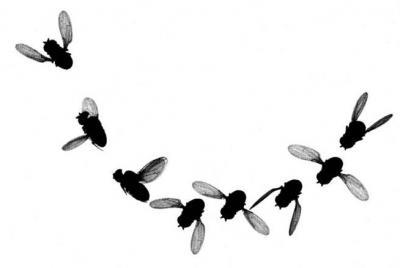Researchers recently used an array of high-speed video cameras operating at 7,500 frames a second to capture the wing and body motion of Drosophila hydei
after they encountered an image of an approaching predator.
The fruit flies are about the size of a sesame seed and rely on a fast visual system to detect approaching predators. And scientists found out that even Top Gun pilots might be envious of the screaming-fast banked turns and slick moves the flies employed. In the midst of a banked turn, the flies can roll on their sides 90 degrees or more, almost flying upside down at times.
"Although they have been described as swimming through the air, tiny flies actually roll their bodies just like aircraft in a banked turn to maneuver away from impending threats," said University of Washington professor of biology
Michael Dickinson,
co-author of a paper on the findings in Science. "We discovered that fruit flies alter course in less than one one-hundredth of a second, 50 times faster than we blink our eyes, and which is faster than we ever imagined."

A fruit fly, Drosophila hydei, flaps its wings 200 times a second during normal flight and even faster when taking evasive action. Credit: F. Muijres and F. van Breugel, University of Washington
The researchers synchronized three high-speed cameras each able to capture 7,500 frames per second, or 40 frames per wing beat. The cameras were focused on a small region in the middle of a cylindrical flight arena where 40 to 50 fruit flies flitted about. When a fly passed through the intersection of two laser beams at the exact center of the arena, it triggered an expanding shadow that caused the fly to take evasive action to avoid a collision or being eaten.
With the camera shutters opening and closing every one thirty-thousandth of a second, the researchers needed to flood the space with very bright light, Muijres said. Because flies rely on their vision and would be blinded by regular light, the arena was ringed with very bright infrared lights to overcome the problem. Neither humans nor fruit flies register infrared light.
How the fly's brain and muscles control these remarkably fast and accurate evasive maneuvers is the next thing researchers would like to investigate.
Fly body roll as it executes a banked turn after seeing a looming shadow (off camera). The video has been slowed down 300 times. The maneuver is also depicted in two animated sequences; the final segment can be viewed in 3-D with red/cyan glasses. Credit: F. Muijres, University of Washington
"These flies normally flap their wings 200 times a second and, in almost a single wing beat, the animal can reorient its body to generate a force away from the threatening stimulus and then continues to accelerate," said Dickinson. "The brain of the fly performs a very sophisticated calculation, in a very short amount of time, to determine where the danger lies and exactly how to bank for the best escape, doing something different if the threat is to the side, straight ahead or behind.
"How can such a small brain generate so many remarkable behaviors? A fly with a brain the size of a salt grain has the behavioral repertoire nearly as complex as a much larger animal such as a mouse. That's a super interesting problem from an engineering perspective."

Time lapse images from a high speed video shows how a fruit fly startled by a looming shadow (off camera at the bottom right) performs a rapid roll to bank away from the threat. Credit: F. Muijres, University of Washington




Comments